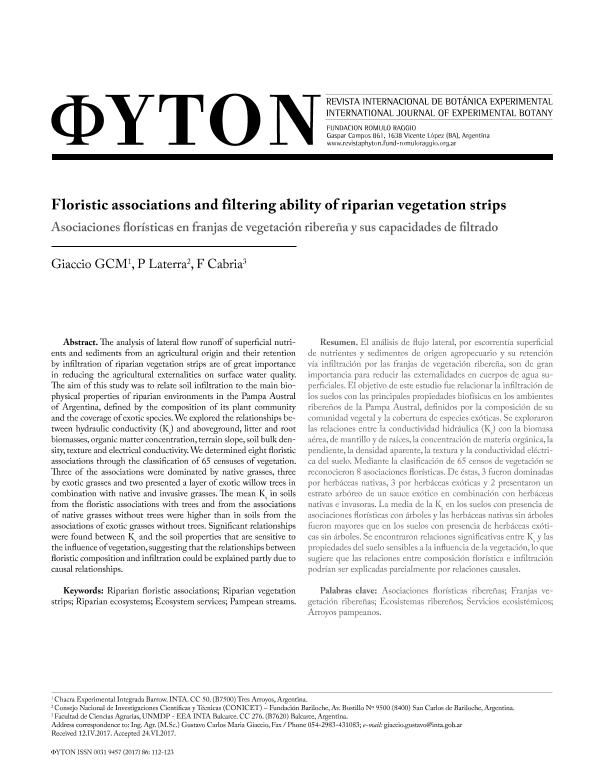Artículo
The analysis of lateral flow runoff of superficial nutrients and sediments from an agricultural origin and their retention by infiltration of riparian vegetation strips are of great importance in reducing the agricultural externalities on surface water quality. The aim of this study was to relate soil infiltration to the main biophysical properties of riparian environments in the Pampa Austral of Argentina, defined by the composition of its plant community and the coverage of exotic species. We explored the relationships between hydraulic conductivity (Ks ) and aboveground, litter and root biomasses, organic matter concentration, terrain slope, soil bulk density, texture and electrical conductivity. We determined eight floristic associations through the classification of 65 censuses of vegetation. Three of the associations were dominated by native grasses, three by exotic grasses and two presented a layer of exotic willow trees in combination with native and invasive grasses. The mean Ks in soils from the floristic associations with trees and from the associations of native grasses without trees were higher than in soils from the associations of exotic grasses without trees. Significant relationships were found between Ks and the soil properties that are sensitive to the influence of vegetation, suggesting that the relationships between floristic composition and infiltration could be explained partly due to causal relationships. The analysis of lateral flow runoff of superficial nutrientsand sediments from an agricultural origin and their retentionby infiltration of riparian vegetation strips are of great importancein reducing the agricultural externalities on surface water quality.The aim of this study was to relate soil infiltration to the main biophysicalproperties of riparian environments in the Pampa Australof Argentina, defined by the composition of its plant communityand the coverage of exotic species. We explored the relationships betweenhydraulic conductivity (Ks) and aboveground, litter and rootbiomasses, organic matter concentration, terrain slope, soil bulk density,texture and electrical conductivity. We determined eight floristicassociations through the classification of 65 censuses of vegetation.Three of the associations were dominated by native grasses, threeby exotic grasses and two presented a layer of exotic willow trees incombination with native and invasive grasses. The mean Ks in soilsfrom the floristic associations with trees and from the associationsof native grasses without trees were higher than in soils from theassociations of exotic grasses without trees. Significant relationshipswere found between Ks and the soil properties that are sensitive tothe influence of vegetation, suggesting that the relationships betweenfloristic composition and infiltration could be explained partly due tocausal relationships.
Floristic associations and filtering ability of riparian vegetation strips
Título:
Asociaciones florísticas en franjas de vegetación ribereña y sus capacidades de filtrado
Fecha de publicación:
06/2017
Editorial:
Fundación Rómulo Raggio
Revista:
Phyton
ISSN:
0031-9457
e-ISSN:
1851-5657
Idioma:
Inglés
Tipo de recurso:
Artículo publicado
Clasificación temática:
Resumen
Archivos asociados
Licencia
Identificadores
Colecciones
Articulos(CCT - PATAGONIA NORTE)
Articulos de CTRO.CIENTIFICO TECNOL.CONICET - PATAGONIA NORTE
Articulos de CTRO.CIENTIFICO TECNOL.CONICET - PATAGONIA NORTE
Citación
Giaccio, Gustavo Carlos María; Laterra, Pedro; Cabria, Fabián Néstor; Floristic associations and filtering ability of riparian vegetation strips; Fundación Rómulo Raggio; Phyton; 86; 6-2017; 112-123
Compartir




